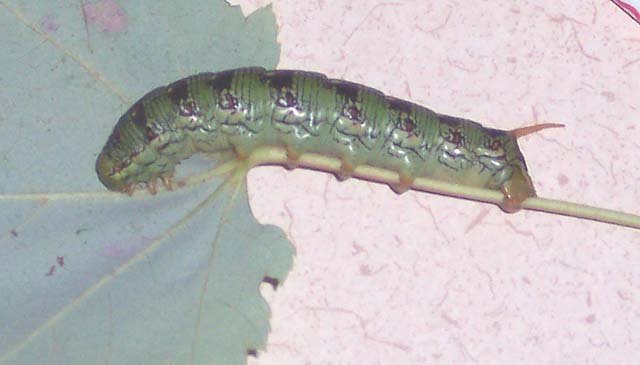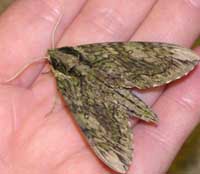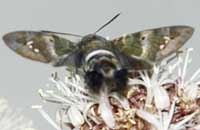|
|
Inspired by and dedicated to Jennifer Nicholson, October 2005
Updated as per BAMONA; June 28, 2019
|
Allegan County, Michigan, and Nearby Counties
Ottawa; Ionia; Barry; Berrien; Cass; St. Joseph
Sphingidae

Hyles lineata, larva, October 13, 2005, Allegan County, courtesy of Jennifer Nicholson
This page is inspired by and dedicated to Jennifer Nicholson who sent me the image of the Hyles lineata larva at the top of this page.
Jennie writes, "Newsflash!!
"An unidentified caterpillar was captured in northeast Allegan County. He was trying to go south in the northbound lane of a residential street.
"He was picked up by a curious mom with a very curious 4 yr old on the way to the bus stop to get her 6 yr old. He doesn’t seem to be
very interested in Maple leaves.
"I would love to know what kind he is, I think he may be a Hyles lineata, but I am not sure."
Hyles lineata can be very variable in thier appearance; Jennifer has correctly identified this one.
Forty-six Sphingidae species are listed in the USGS (now BAMONA) for Michigan. Not all of the species are reported (only five by BAMONA, June 28, 2019:
Lapara bombycoides; Paonias myops; Eumorpha pandorus; Amphion floridensis; Hyles lineata) in Allegan County in southwestern Michigan of 2013.
I have added many species which I feel may be present, in addition to the Hyles lineata confirmed by Jennifer (JN) and/or the
species reported by BAMONA.
It is hoped that this checklist, with the thumbnails and notes, will help you quickly identify the moths you have encountered.
A WO" after the species name indicates that I have no confirmed reports of this species in Allegan County, but
I (William Oehlke) expect that these moths are present.
Please help me develop this list with improved, documented accuracy by sending sightings (species, date, location), preferably with an
image, via email to Bill Oehlke.
Please also forward your sightings to BAMONA an excellent resource.
Although this page was originally created to cover Allegan County, it is also a valid checklist for what is expected in nearby counties:
Ottawa: Hemaris diffinis; Eumorpha pandorus; Amphion floridensis; Hyles lineata;
Ionia: Manduca quinquemaculatus; Amphion floridensis;
Barry: Paonias excaecata; Darapsa myron;
Berrien: Ceratomia undulosa; Dolba hyloeus; Lapara bombycoides; Manduca quinquemaculatus; Manduca sexta; Sphinx chersis; Sphinx kalmiae;
Amorpha juglandis; Pachysphinx modesta; Paonias excaecata; Paonias myops; Aellopos tantalus; Hemaris diffinis; Hemaris thysbe; Eumorpha pandorus;
Darapsa choerilus; Darapsa myron; Hyles lineata;
Cass: Ceratomia undulosa; Dolba hyloeus; Manduca sexta; Sphinx canadensis; Amorpha juglandis; Pachysphinx modesta;
Darapsa myron; Darapsa versicolor;
St. Joseph: Hemaris thysbe; Darapsa myron.
Visit Sphingidae of the Americas to access similar Sphingidae lists for all US states and counties, all Canadian provinces,
Mexico, all Central and South American countries.
Visit North American Catocala to access pictoral checklists for Catocala
(underwing moths) for all US states and all Canadian provinces.
Sphinginae subfamily
Sphingini tribe:
 |
Agrius cingulata,
WO Pink-spotted hawkmoth,
stray
This species is a strong migrant and adults nectar from
deep-throated flowers including moonflower (Calonyction aculeatum),
morning glory (Convolvulus), honey suckle (Lonicera)
and petunia (Petunia species).
|
 |
Ceratomia amyntor
WO,
the Elm Sphinx or Four-horned Sphinx
This moth is not officially recorded in Van Buren County,
but I suspect it is present.
Larvae feed on Elm (Ulmus), birch (Betula), basswood (Tilia), and
cherry (Prunus). |
 |
The upperside of the forewing is yellowish brown with no white
markings, but there are indistinct black lines and dashes. The cell
spot is gray with a black outline and the upperside of the hindwing
is yellowish brown with obscure lines.
Catalpa is the larval host. |
 |
Ceratomia hageni
WO,
Hagen's Sphinx or Osage Orange Sphinx
The upperside of the forewing is gray with a green tint and has dark
indistinct wavy lines, and pale gray patches at the wing tip and
along the costa.
generally a more southerly species |
 |
The upperside of the forewing is pale brownish gray with wavy black
and white lines and a black-outlined white cell spot. |
 |
Dolba hyloeus
WO/Berrien/Cass, the Pawpaw Sphinx
The upperside of the forewing is dark brown with a dusting of white
scales. Some moths have patches of reddish or yellowish brown on the
wings.
Larve are not limited to pawpaw.
|
 |
Lapara bombycoides
Allegan/Berrien, the
Northern Pine Sphinx
The upperside of the forewing is gray with heavy black bands. The upperside of the hindwing is brownish gray with no markings.
If you have pines, you
might have this species. It flies on P.E.I.
|
 |
The upperside of the forewing is gray-brown with wavy lines, black dashes, and
one or two small white spots near the center of the costa. |
 |
This large bodied moth flies in tobacco fields and vegetable gardens
(potatoes, tomatoes) and wherever host plants are found. |

|
Manduca sexta WO/Berrien/Cass, the Carolina Sphinx
The upperside of the hindwing is banded with black and white and has
two black zigzag median lines that are very close together with
hardly any white showing between them
Larvae get very large and can strip a tomato plant.
|

|
Sphinx canadensis
WO//Cass,
Sphinx canadensis, the Canadian Sphinx, is not common, and is not often reported anywhere,
but it might possibly be present in Allegan County.
Larval hosts are white ash (Fraxinus americana) and blueberry
(Vaccinium).
|
 |
Sphinx chersis
WO/Berrien, the Northern Ash
Sphinx or Great Ash Sphinx
The upperside of the forewing is soft dark gray to blue-gray with a series of black dashes,
one of which reaches the wing tip. |
 |
Forewings, long and slender, are held close to the body when the
moth is at rest. We have them on P.E.I.,
but I do not see them nearly as frequently as I see the other Sphingidae. |
 |
Sphinx kalmiae
WO/Berrien, the Laurel Sphinx
The lower forewings are predominantly brownish-yellow with a fairly
wide dark bar along the inner margin. At rest the wings hug the body,
giving the moth a long slender look.
|
 |
Sphinx luscitiosa
WO,
the Canadian Sphinx or
Clemen's Sphinx
The upperside of the forewing is yellowish gray in males and pale
gray with a faint yellow tint in females. In both sexes, the dark
border on the outer margin widens as it approaches the inner margin.
|
 |
If you have blueberries in the woods, then you probably have the
Poecila Sphinx. They are pretty common here on Prince Edward Island,
but don't fly too far south of Massachusetts, being replaced by
Sphinx gordius in Connecticut. |
Smerinthini Tribe:
 |
Amorpha juglandis
WO/Berrien/Cass,
the Walnut Sphinx
The adults are also highly variable; sometimes wings of an individual
may be all one color or may have several colors, ranging from pale to
dark brown, and may have a white or pink tinge.
See the file for the female; she is different. |
 |
Paonias excaecata
WO/Barry/Berrien, the Blinded Sphinx,
The outer margin of the forewing is quite wavy. There is a dark cell spot and a dark oblique line mid wing from the costa almost to the
inner margin. Basic ground colour is pinkish brown. Flight would be June-July. |
 |
Paonias myops
Allegan/Berrien,
the Small-eyed Sphinx
This small species is probably widespread and common. This species ranges across North America.
The hindwings have a small blue eyespot ringed with black on a yellow background.
|
 |
Pachysphinx modesta
WO/Berrien/Cass,
the Modest Sphinx or Poplar Sphinx,
This moth has a large, heavy body, and
females can be remarkably plump.
|
 |
Smerinthus cerisyi
WO, the Cerisyi's
Sphinx or One-eyed Sphinx, Larvae feed on poplars and willows.
Flight would be from late May-July as a single brood. I suspect it is
present.
|
 |
This moth is widely distributed and fairly common, but it is recorded
in Allegan.
Along the East Coast, it flies from P.E.I. to Florida. |
Macroglossinae subfamily
Dilophonotini Tribe:
 |
The body is reddish brown with a wide white band across the abdomen.
The forewing upperside is reddish brown with a black cell spot and 3
white spots near the gray marginal area. A pale streak runs from
the cell spot to the inner margin of the wing. This woould be a very rare stray.
|
See Hemaris comparison
to help distinguish the next three species.
 |
Hemaris diffinis
WO/Ottawa/Berrien, the Snowberry Clearwing or Bumblebee Moth,
The moth flies along forest edges and in meadows, gardens and
brushy fields. Day-flying adults nectar at lantana, dwarf bush honeysuckle,
snowberry, orange hawkweed, thistles, lilac, Canada violet, etc.
|
 /td> /td> |
Hemaris gracilis
WO, the
Slender Clearwing or Graceful Clearwing
Hemaris gracilis is distinguished from similar species by a pair of
red-brown bands on the undersides of the thorax, which varies from
green to yellow-green dorsally and sometimes brown with white
underneath. questionable
|
 |
Hemaris thysbe
WO/Berrien/St. Joseph, the Hummingbird Clearwing
This interesting day flier is not confirmed for Allegan.
They are widely distributed in the east from P.E.I. to Florida. |
Philampelini Tribe:
 |
This moth is not reported in Allegan. It is fairly often
reported along the east coast from southern New Jersey
to central Maine.
Note the differences between this moth and the Pandorus Sphinx. |
 |
Eumorpha pandorus
Allegan/
Ottawa/Berrien/, the
Pandorus Sphinx
If you have Grape or Virginia Creeper nearby, then you probably have
this species. I often get asked to identify larvae from areas where
they have not previously been reported. |
Macroglossini Tribe:
 |
Amphion floridensis
Allegan/Ottawa/Ionia:, the Nessus Sphinix
This day flier is widely distributed. If you have Virginia Creeper,
you probably have the Nessus Sphinx. Two bright, distinct, narrow
yellow bands are often visible on the abdomen.
|
 |
They are common in New Jersey and common
here on Prince Edward Island.
You will often see this species listed as Darapsa pholus,
especially in older literature. |
 |
Darapsa myron
WO/Barry/Berrien/Cass/St. Joseph, the Virginia Creeper Sphinx or the
Grapevine Sphinx
This moth is not recorded on the U.S.G.S. site for Allegan County,
but it should be present.
It is widely reported as far north as southern Maine. If you have the
foodplants indicated in the common names, you probably have this
species nearby. |
 |
If you have hydrangea growing near a stream, then you may have the
Hydrangea Sphinx. However, it
probably is uncommon.
|
 |
The moth's outer margin of the forewing is deeply scalloped.
The upperside is light brown with dark brown markings.
There is a small black and white spot near the tip.
The upperside of the hindwing is orange-brown with a dark brown
outer margin and median line.
|
 |
Hyles gallii
WO, the Bedstraw Hawk Moth
or Gallium Sphinx
This species is not reported in Allegan County, but it may be present.
Some years I see them on P.E.I., some years, I do not.
|
 |
Hyles lineata
JN/Allegan/Ottawa/Berrien, the White-lined Sphinx
Adults usually fly at dusk, during the night, and at dawn, but they
also fly during the day over a wide variety of open habitats
including deserts, suburbs, and gardens. |
 |
This moth is very much under reported on USGS. It is a
rapid day flier so is probably not in too many collections.
Grape is a popular larval host.
|
 |
This moth is much more common to the south and east. It is a strong
migrant, however, and may stray to Allegan County.
|
|
|
Use your browser "Back" button to return to the previous page.
Enjoy some of nature's wonderments, giant silk moth cocoons.
These cocoons are for sale winter and fall. Beautiful Saturniidae moths will emerge the following spring and summer.
Read Actias luna rearing article.
Additional online help available.
Eggs of many North American species are offered during the spring and summer. Occasionally
summer Actias luna and summer Antheraea polyphemus cocoons are available. Shipping to US destinations is done
from with in the US.
Use your browser "Back" button to return to the previous page.
This page is brought to you by Bill Oehlke and the
WLSS. Pages are on space rented from Bizland. If you would like
to become a "Patron of the Sphingidae Site", contact Bill.
Please send sightings/images to Bill. I will do my best to respond to requests for identification help.
 | 
Show appreciation for this site by clicking on flashing butterfly to the left.
The link will take you to a page with links to many insect sites. |
This website has been created and is maintained by Bill Oehlke without government or institutional financial assistance. All expenses, ie., text reference
support material, webspace rental from Bizland, computer repairs/replacements, backups systems, software for image adjustments (Adobe Photoshop; L-View),
ftp software, anti-virus protection, scanner, etc. are my own.
I very much appreciate all the many images that have been sent to me, or of which I have been granted permission to copy and post from other websites.
All images on this site remain the property of respective photographers.
If you would like to contribute to the maintenance of this website by sending a contribution to
Bill Oehlke
Box 476
155 Peardon Road
Montague, Prince Edward Island, C0A1R0
Canada
your donation would be much appreciated and would be used for
1) paying for webspace rental;
2) paying for computer maintenance and software upgrades;
3) purchases of additional text reference material (journals and books) in anticipation of expanding the site to a worldwide Sphingidae site;
4) helping to pay my daughter's tuition (completed spring of 2013); with anything left over going to humanitarian aid.
If you are mailing a check from USA, please use $1.25 (2019 rate) postage. Donations can also be made through Paypal via the button below.

